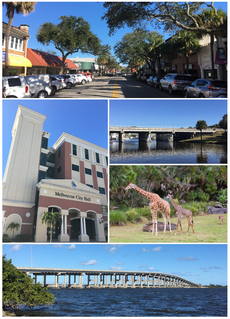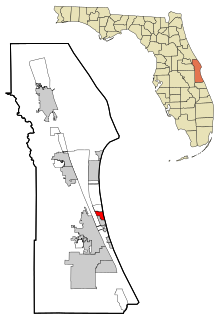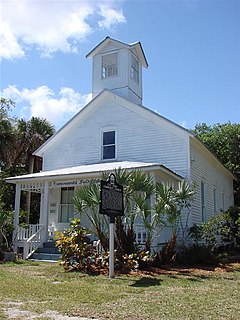
Brevard County is located in the east central portion of the U.S. state of Florida. As of the 2010 census, the population was 543,376, making it the 10th most populated county in Florida. The official county seat has been located in Titusville since 1894. Brevard County comprises the Palm Bay–Melbourne–Titusville, FL Metropolitan Statistical Area. It is located along the east Florida coast and bordered by the Atlantic Ocean.

Melbourne is a city in Brevard County, Florida, United States. It is seventy-two miles southeast of Orlando. As of the 2010 census, there was a population of 76,068. The municipality is the second-largest in the county by both size and population. Melbourne is a principal city of the Palm Bay – Melbourne – Titusville, Florida Metropolitan Statistical Area. In 1969, the city was expanded by merging with nearby Eau Gallie.

Merritt Island is a census-designated place (CDP) in Brevard County, Florida, United States, located on the eastern Floridian coast, along the Atlantic Ocean. The population was 34,743 at the 2010 census. It is part of the Palm Bay – Melbourne – Titusville, Florida Metropolitan Statistical Area. The name "Merritt Island" also refers to the extent of the peninsula, misnamed an "island".

Satellite Beach is a coastal city in Brevard County, Florida. The population was 10,109 at the 2010 United States Census, and it is located with the Atlantic Ocean to the east and the Indian River to the west.

Titusville is a city and the county seat of Brevard County, Florida, United States. The city's population was 43,761 as of the 2010 United States Census. Titusville is located along the Indian River, west of Merritt Island and the Kennedy Space Center, and south-southwest of the Canaveral National Seashore. It is a principal city of the Palm Bay–Melbourne–Titusville Metropolitan Statistical Area.

The Space Coast is a region in the U.S. state of Florida around the Kennedy Space Center (KSC) and Cape Canaveral Space Force Station. It is one of several "themed" coasts around Florida. All of NASA-launched crewed spaceflights have departed from either KSC or Cape Canaveral. The Air Force Station has also launched unmanned military and civilian rockets. Cities in the area include Titusville, Cocoa, Rockledge, Cape Canaveral, Merritt Island (unincorporated), Cocoa Beach, Melbourne, Indialantic, Palm Bay, and Viera (unincorporated). Most of the area lies within Brevard County. It is bounded on the south by the Treasure Coast, on the west and north by Central Florida, and on the east by the Atlantic Ocean.

Hurricane Erin was the first hurricane to strike the United States since Hurricane Andrew in 1992. The fifth tropical cyclone, fifth named storm, and second hurricane of the unusually active 1995 Atlantic hurricane season, Erin developed from a tropical wave near the southeastern Bahamas on July 31. Moving northwestward, the cyclone intensified into a Category 1 hurricane on the Saffir–Simpson scale near Rum Cay about 24 hours later. After a brief jog to the north-northwest on August 1, Erin began moving to the west-northwest. The cyclone then moved over the northwestern Bahamas, including the Abaco Islands and Grand Bahama. Early on August 2, Erin made landfall near Vero Beach, Florida, with winds of 85 mph. The hurricane weakened while crossing the Florida peninsula and fell to tropical storm intensity before emerging into the Gulf of Mexico later that day.

Hurricane Abby made landfall in Cuba, Florida, and North Carolina in June 1968. The first tropical cyclone, first named storm, and first hurricane on the season, Abby developed over the northwestern Caribbean Sea on June 1, as a result of the interaction between a mid-tropospheric trough and a cold front. Moving generally north-northeastward, the depression slowly strengthened while approaching the western tip of Cuba, becoming Tropical Storm Abby late on June 2. Shortly thereafter, Abby made landfall in Pinar del Río Province. The storm dropped heavy rainfall in western Cuba, with up to 12 inches (300 mm) on Isla de la Juventud. However, no flooding was reported. After reaching the southeastern Gulf of Mexico on June 3, Abby strengthened further and became a Category 1 hurricane on the modern-day Saffir–Simpson hurricane wind scale. However, early on June 4, Abby weakened to a tropical storm. Around midday on June 4, the system made landfall near Punta Gorda, Florida as a strong tropical storm.

The City Point Community Church is a historic church in Cocoa, Florida, United States. It is located at 3783 North Indian River Drive.

St. John's Baptist Church is a historic church in Miami, Florida. It is located at 1328 Northwest 3rd Avenue. On April 17, 1992, it was added to the U.S. National Register of Historic Places.

Ruge Hall is a historic site in Tallahassee, Florida. It is located at 655 West Jefferson Street. On August 1, 1997, it was added to the U.S. National Register of Historic Places.

The First Presbyterian Church in Chattanooga, Tennessee, located at 554 McCallie Avenue, is a historic, downtown congregation of the Presbyterian Church in America (PCA) and the first Christian congregation founded in Chattanooga.

Environmental issues in Brevard County in Florida United States are highlighted by the amount of waterline, the amount of wetlands, the quantity of residents and visitors to the area, as well as the usual threat to air quality from commuters. Assisting in this is the Florida Space Coast Clean Cities Coalition which headquartered in Brevard. It encompasses a nine-county area.

The Air Force Space and Missile Museum is located at Launch Complex 26 at Cape Canaveral Space Force Station, Florida. It includes artifacts from the early American space program and includes an outdoor area displaying rockets, missiles, and space-related equipment chronicling the space and missile history of the US Space Force and other military branches.
Brevard County has a county government, municipal governments, and various Florida state and U.S. federal agencies.
The History of Brevard County can be traced to the prehistory of native cultures living in the area from pre-Columbian times to the present age. Brevard County is a county in the U.S. state of Florida, along the coast of the Atlantic Ocean. The geographic boundaries of the county have changed significantly since its founding. The county is named for Judge Theodore W. Brevard, an early settler, and state comptroller. The official county seat has been located in Titusville since 1894, although most of the county's administration is performed from Viera.

King's Chapel is a small chapel in the British Overseas Territory of Gibraltar. It is located at the southern end of Main Street and adjoins the Governor of Gibraltar's residence, The Convent. What nowadays is King's Chapel was the first purpose-built church to be constructed in Gibraltar. Originally part of a Franciscan friary, the chapel was built in the 1530s but was given to the Church of England by the British after the capture of Gibraltar in 1704. It was badly damaged in the late 18th century during the Great Siege of Gibraltar and in the explosion of an ammunition ship in Gibraltar harbour in 1951, but was restored on both occasions. From 1844 to 1990 it served as the principal church of the British Army in Gibraltar; since then it has been used by all three services of the British Armed Forces.

Hurricane Floyd in 1999 threatened Florida as a major hurricane roughly three times as large as Hurricane Andrew. Floyd originated from a tropical wave well east of the Lesser Antilles on September 7. While approaching the Bahamas, the storm strengthened significantly between September 12 and September 13. On the latter day, Floyd peaked as a strong Category 4 hurricane on the Saffir–Simpson scale. However, upon moving closer to the Bahamas, the storm fluctuated in intensity between a Category 3 and a Category 4 hurricane. A subtropical ridge eroded by a mid- to upper-tropospheric trough over the eastern United States caused Floyd to curve northwestward over the Abaco Islands and later to northeast, avoiding a potentially catastrophic landfall in Florida. The storm made its closest approach to Florida early on September 15, passing about 110 mi (180 km) east of Cape Canaveral.

Hurricane Matthew was the strongest tropical cyclone to affect the First Coast of Florida since 1898. A late-season Category 5 hurricane in late 2016, Matthew was the first hurricane to threaten the Floridan coastline as a major hurricane since Wilma in 2005. While the center of the storm did not actually cross the coastline, the western eyewall of the storm paralleled the coast, with the most eastern portions receiving winds up to Category 2 strength. The storm caused at least three direct deaths and eleven indirect, and up to $1.49 billion in damages.

Hurricane Michael was a very powerful and destructive tropical cyclone that became the first Category 5 hurricane to strike the contiguous United States since Andrew in 1992. In addition, it was the third-most intense Atlantic hurricane to make landfall in the contiguous United States in terms of pressure, behind the 1935 Labor Day hurricane and Hurricane Camille in 1969. It was the first Category 5 hurricane on record to impact the Florida Panhandle, the fourth-strongest landfalling hurricane in the contiguous United States, in terms of wind speed, and the most intense hurricane on record to strike the United States in the month of October.




















